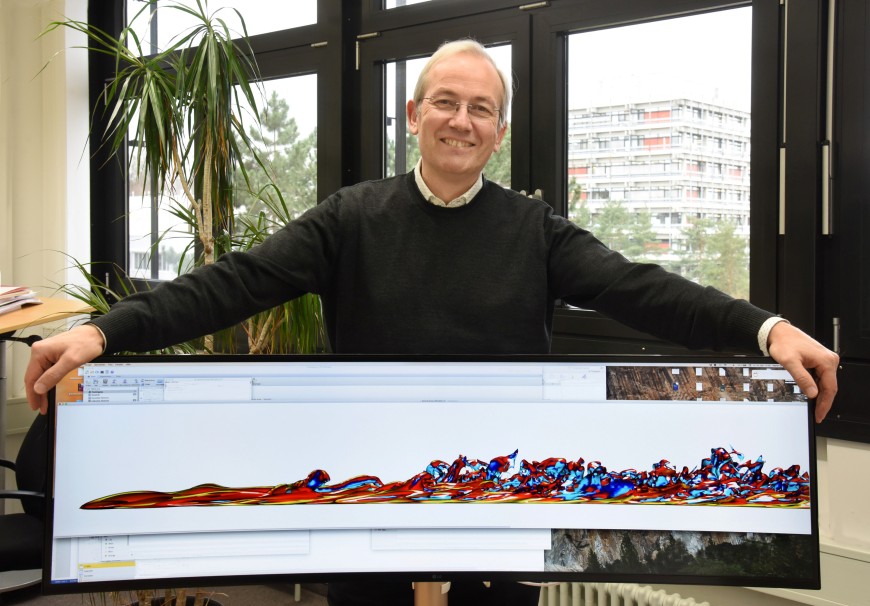Better aerodynamics thanks to mathematical thinking
Publication in “Physical Review Letters”
2022/01/11 by Christian J. Meier
A team led by the Darmstadt mechanical engineering professor, Martin Oberlack, has discovered fundamental principles that make it easier to calculate turbulence than was previously possible. This could significantly reduce time-consuming experiments in wind tunnels as they could be simulated on the computer.

What does a maths problem that has remained unsolved for a hundred years have to do with the fuel consumption of aircraft? Quite a lot when it comes to calculating aerodynamic drag. A team led by Prof. Martin Oberlack from the Technical University of Darmstadt has now found a solution that could make time-consuming experiments in huge wind tunnels in some cases superfluous.
“This is a great success,” says Oberlack. The scientific journal Physical review Letters agrees and particularly highlights the work of the researchers from the Instiute of Fluid Dynamics and the Technical University of Valencia. The new method considerably simplifies the calculation of the aerodynamics along a flat surface. It could enable computer simulations that today overwhelm even the most powerful supercomputers.
“To simulate the air flows around an Airbus 380 would need a mainframe, the likes of which will probably not exist for another 40 years,” says Oberlack. This is because countless tiny turbulences make the simulation extremely complex.
This is why researchers measure the air flows directly on the object, in wind tunnels. “That too is a gigantic effort that we would like to save,” says Oberlack. He sees the solution to the dilemma in making the simulations manageable for present day computers. Then digital models of components, such as landing flaps, could be placed in a virtual air flow. Even small optimisations would be useful: “In aviation every per cent of fuel saved counts,” says Oberlack.
But how can computer simulations be simplified? “Instead of calculating each single air vortex, it would be enough to simulated statistical mean values such as the average speed of the air,” says the aerospace engineer.
But the experiment creates a new problem. In order to calculate the mean values, the so-called Navier-Stokes equations must be transformed. These generally describe flows of fluids and gases. However, the transformation results in an infinitely long chain of new equations. “Also, a computer cannot cope with the many new equations,” says Oberlack.
The team led by the Darmstadt mechanical engineer sidestepped into the analogue. They solved the equations with paper and pencil, in other words by mathematical analysis. The starting point was an aerodynamic law that describes the flow of air along a flat surface, the so-called logarithmic wall law, discovered by Theodore von Karman about 100 years ago.
Oberlack’s team proved that this law is a solution of the first equation from the infinite chain of equations mentioned above. But it gets even better: “Solutions to all further equations result from this solution,” says Oberlack. This means that all statistical values such as the mean velocity and other values such as the variance can be calculated.
However, this only applies to the special case of a flat surface. Even a supercomputer can still solve this simple case very accurately, but it takes a very long time to do it: Even one of the world’s most powerful supercomputers at the Leibniz Supercomputing Centre in Garching (SuperMUC NG) took three years. Finally, the computer confirmed the new laws of the researchers under Oberlack.
A landing flap is, of course, a much more complicated shape. “But we are cautiously optimistic that we will find solutions to this as well,” says Oberlack. The team already has ideas. So wind tunnels are getting competition from the realm of mathematics.
Publication
Martin Oberlack, Sergio Hoyas, Stefanie V. Kraheberger, Francisco Alcántara-Ávila, and Jonathan Laux: Turbulence Statistics of Arbitrary Moments of Wall-Bounded Shear Flows: A Symmetry Approach. Phys. Rev. Lett. 128, 024502.
